Top 12 Fuzz Pedals From $30 to +$200
The Fuzz Guide
The Fuzz Effect
Fuzz Origins
The fuzz effect stands as one of the most important and vital guitar effects in history.
Going back to the ’60s and the recordings of Jimi Hendrix through David Gilmour in the ’70s and a wave of indie players in the ’80s and ’90s, the fuzz sound in all its glitchy glory has remained a central tool in the belt of all ranks of rock guitarist.

Tried and true classics like the Fuzz Face and Electro-Harmonix Big Muff Pi remain as popular as ever, while a new generation of boutique builders have also churned out hundreds upon hundreds of new designs for players to explore.
Where to put it in the signal chain?
The most common recommendation is to use the fuzz pedals as one of the first pedals of the signal chain. Otherwise, the signal could get too noisy.
So, as a rule of thumb put the Fuzz pedal after compressors and before delays and other modulation pedals.

As for the overdrives, you can put them before or after, but if you like to boost the Fuzz effect with an overdrive, just experiment with the overdrive pedal before or after and check what sounds better to you.
Putting overdrive pedals before fuzz pedals seem to produce smoother sounds. Contrary, putting the overdrive after the fuzz usually outputs more crunch and attack.
Where Can I Find The Best Fuzz Pedals?
Selecting the best quality/price fuzz pedal can be pretty easy if you know your budget and sound preferences. Keep in mind that as the price increases also do the pedal capabilities and its unique features, so it becomes a more personal decision rather than just looking for the best sounding pedal.
For example, the Electro-Harmonix Nano Big Muff probably has the best fuzz sound, or at least, the sound that we expect to get from a fuzz pedal.
But if you want to explore new sounds you could try the Ibanez 850 FuzzMini, which provides two effects in a compact format: a cleaner fuzz and a similar Tube Screamer overdrive.
In case you don’t know where to start, here is my base recommendation:
- For $30 you could try the Donner Stylish Fuzz, which has everything that most of us asks for a fuzz pedal
- Around the $100 you can find a modernized version of one of the classics fuzz pedals: the Electro-Harmonix Nano Big Muff
- And for the high-end tier I would go for the Wampler Velvet Fuzz V2. It’s absolutely incredible and versatile and it costs $170
In the following table you can review the specifications of the different pedals we will cover in the next section:
Top 6 Fuzz Pedals Under $100
Behringer Super Fuzz SF300
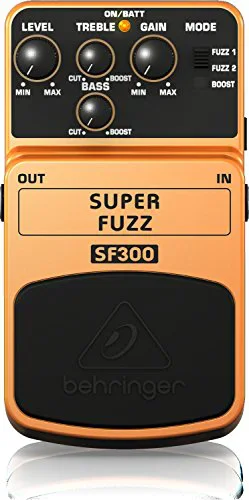
Here we have the Behringer Super Fuzz SF300: the cheapest fuzz pedal you can find on the market providing a more than decent sound quality.
It has four simple controls: Gain, Level and 2-band EQ (bass and treble), instead of the single “Tone” knob that we can usually find in other pedals to equalize the higher frequencies.
- Recreate the fuzz tones from the ’60s and ’70s
- 3 different sound modes for classic fuzz, grunge, and gain boost
- Rugged electronic On/Off switch for highest signal integrity in bypass mode
Overall, this is much more than a FUZZ as it can also be used as a booster and overdrive if you tweak it properly, which can end up being a daunting task…
Donner Stylish Fuzz
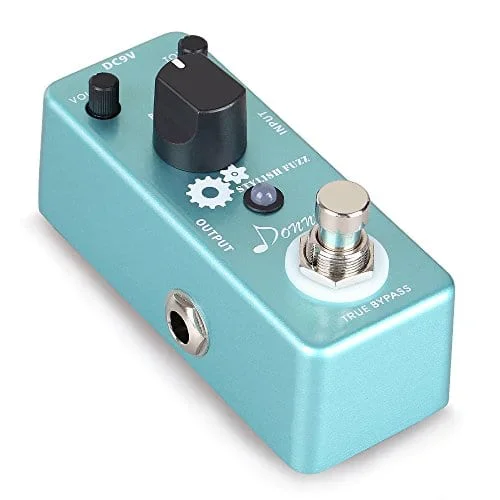
The Donner Stylish Fuzz has become one the best selling fuzz pedals for quite a few reasons:
- It’s really affordable, you can get one for around 30 bucks!
- Uses a durable full aluminum case, which is not always what you can find in this price range
- Easy to use classic fuzz sound pedal with no tricky configurations. That’s usually what most of the people are looking
- +120 reviews on Amazon.com with 4.5 stars out of 5
In my opinion, the Donner Stylish Fuzz is the no-brainer pedal of the Fuzz category. If you want a good sounding fuzz pedal for the lowest price possible, this is your best bet!
The current draw is pretty low if you compare it to other pedals like the Behringer SF400 for example.
It’s a shame that you can’t use a battery with compact pedals like this one… but you could use an external 9V battery with an adapter cable to solve this portability issue.
Joyo JF-12 Voodoo Octave
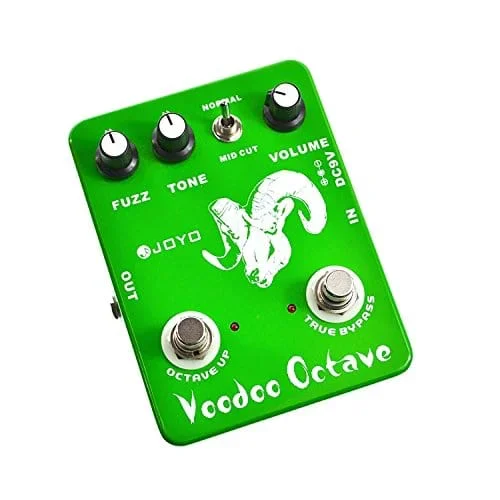
The JF-12 Ultimate Octave pedal from JOYO gives some really cool options to work with:
- As you would expect, you can use this pedal to get a standard Fuzz distortion (based on the Big Muff), which adds tons of layers of harmonics
- But you can also add an octave effect, which can be engaged independentlyof the distortion effect
- Each effect has its own footswitch to enable/disable them separately
The combination of the two effects in one single pedal is what makes it special, and it’s perfect for cool sound effects or alien-sounding tones.
If that wasn’t enough, this pedal also has other nice features like the mid cut switch, which allows you to scoop out some of the body. It also has the standard three knobs to control the values of the fuzz, volume and high-frequencies.
This true-bypass pedal is enclosed in a full aluminum case and supports either 9V batteries or standard 9V power supply.
The JF-12 allows rock, blues, jazz, funk, fusion and even country guitar players to access creative sounds from an affordable and versatile pedal!
Biyang Fuzz Star FZ-10
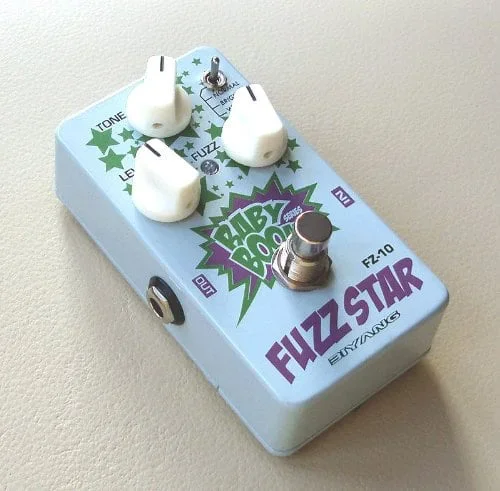
The Biyang FZ-10 Fuzz Star is an incredibly good sounding fuzz pedal. It’s heavily influenced by the classic fuzz pedals but brings a little something extra to the table too.
It’s also available for much less than the mainstream fuzz pedals – don’t pay hundreds extra just for a brand name!
The FZ-10 is one of the Biyang’s Baby Boom pedals family. All pedals in this range are small and lightweight, yet durable and sturdy. They also all have true bypass footswitches to minimize the pedal footprint when it’s not used.
There are the three standard main knobs to control the effect modulation: Tone, Level and Fuzz.
As you’d expect Tone controls the high-frequencies cutoff of your sound (very important on fuzz pedals), while Fuzz controls the amount of distortion (the typical sustain knob found in other fuzz pedals). Level can be adjusted as you add/take away distortion to normalize the output volume.
There is also a 3-way selection switch to select one of the three available modes to further alter your sound:
- Normal: designed to emulate the Big Muff
- Bright: more suitable for rhythm tones
- Warm: darker smooth fuzz tone for lead tones
Ibanez 850 FuzzMini
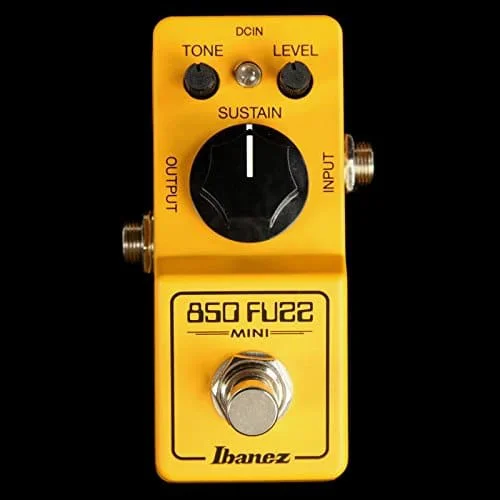
Based on the legendary OD850, the all-analog Ibanez 850 FuzzMini pedal delivers a warm, classic fuzzy sound in a pedalboard-friendly compact design.
Released in early 2017, this tiny pedal has two small knobs allow you to adjust the Tone and Level while a larger knob in the middle of the pedal allows you to adjust the Sustain so you can tinker and tailor until you find your perfect sound.
Featuring a standard true bypass providing the shortest, most direct signal path possible, the 850 FuzzMini doesn’t color your sound when you are not using it.
What makes this pedal special? It can deliver both creamy overdrives and dark fuzzies.
If you want cool overdrive sounds, try with the lower fuzz (sustain knob) settings. As you increase the Level value while keeping the fuzz set to low, you can add a slight, fuzzy grit.
From this point, if you want to feel the real power of this pedal, just set the Sustain knob to one o’clock or more.
There are a lot of thick, juicy sounds with higher gain settings, and you can tame them by adjusting your guitar’s volume knob, which will let you experience a wide array of sounds by just controlling the guitar’s volume control.
Electro-Harmonix Nano Big Muff
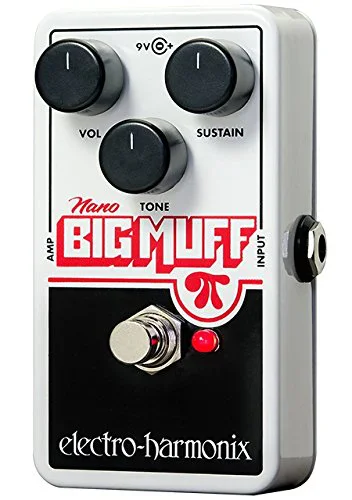
The Electro Harmonix Nano Big Muff is a shrunk version of the classic Big Muff, making it more portable without losing a bit of its legendary character.
For over 40 years, the Big Muff Pi has helped define the sound of rock guitar for its rich, creamy, violin-like sustain. Now you can have it in the time-honored classic chassis, or the new, compact nano design.
As for the controls, let me explain to you what each one does, as it can be a little confusing.
The sustain control adjusts the amount fuzz. Keep in mind that you always get a lot of sustain no matter how you set this control up. And that’s precisely what makes this pedal awesome.
The tone control acts as a high-pass filter, or a treble equalizer if you want.
And finally, we have the volume knob which is pretty straightforward this time: it controls output volume.
Here are some of the key features of the Nano Muff Pi:
- Classic 70’s fuzz sound with a creamy and big sustain
- Compact and robust enclosure
- Comes with a 9 Volt battery
Compared to the standard Big Muff, the Nano version is slightly less bassier as you can see in this comparison video.
Other than that, they are one and the same in terms of components and sound quality. There is not a clear winner between these two pedals, so you will have to decide based on your personal taste which one is more suitable to get your desired tone.
Top 6 Fuzz Pedals Over $100
Dunlop FFM3 Jimi Hendrix
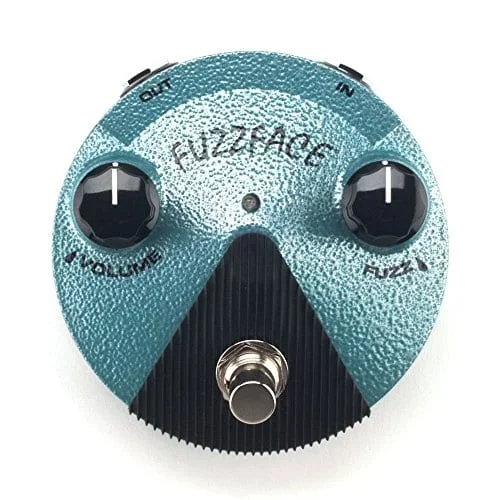
Here we have one of the Mini Fuzz Face pedals by Dunlop: the FFM3 Jimi Hendrix.
- Exact same circuit as the classic JHF1 Hendrix Fuzz Face with BC108 silicon transistor
- Legendary Fuzz Face tones in a pedalboard-friendly housing
- Status LED, battery door
Vintage Silicon Sound
The FFM3 is the latest reissue of the legendary JHF1 Hendrix Fuzz Face, the silicon fuzz pedal Hendrix used himself on classic albums such as Electric Ladyland.
The FFM3 Mini Fuzz Face captures the essence of this classic fuzz pedal thanks to the usage of the BC108 silicon transistor.
It gives you the same thick, smooth fuzz sound in a more compact size, perfect for lightweight pedalboards.
This modernized version also includes some enchantments such as a true bypass switching and a bright status LED.
Smaller Footprint
If you ever see an original / standard-sized fuzz face you will see probably its main inconvenience: it’s huge (and heavy).
Thankfully, the FFM3 has improved the classic design, encapsulating the very same circuitry in a smaller/compact housing so you don’t have the excuse to sacrifice your favorite fuzz pedal anymore!
Variations Of The Fuzz Face Mini
There are other Fuzz Face Mini variations, including Germanium and Silicon models as well as other signature flavors (Hendrix, Bonamassa, Eric Johnson). They all have similar prices but slightly different sounds, so make sure to check them out!
Fulltone ’70 BC-108C
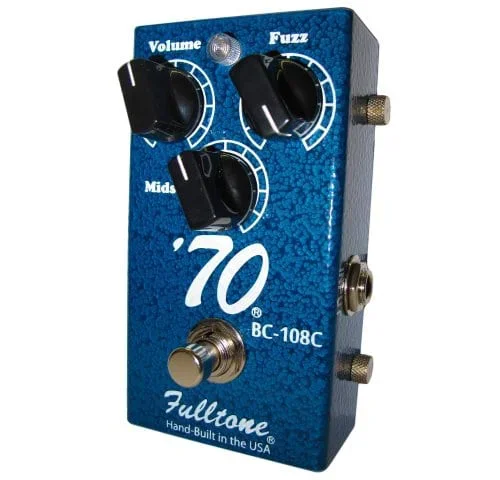
- Reissue of the Fulltone 70 fuzz in a smaller (OCD-sized) housing
- 16-gauge steel enclosure
- Mid knob provides extra clarity and cut
- Ideal for older 4-input Marshall amps
- Two BC108C transistors, intentionally mismatched for harmonic content
Modernized Fulltone ’70
Thanks to a recent find of a couple thousand excellent BC108C transistors, Fulltone announced the return of the 70 Fuzz pedal, this time in a small (OCD-sized) housing.
These transistors sound outrageous, and the resulting 70-BC Fuzz pedal still has the secret-weapon “Mid” knob which will allow you reach sounds other Fuzz Faces couldn’t.
As other Fuzz Face reissued replicas, the Fulltone ’70 has also a redesigned housing to reduce its footprint and make it more portable. In case you are curious, this is how the classic Fulltone ’70 looked like.
Transistors Configuration
The Fulltone 70-BC has two intentionally mismatched (for harmonic content) silicon transistors that snarl and spit-not for the meek!
If you put the Fuzz knob at 10 o’clock you will rip, and you might get all sorts of oscillation and weirdness, but that’s what rock is about, right?
Use it with a wah-wah and you will get the screaming and howling tones that you would recognize from Jimi’s solos.
Exploring The Controls
We have two knobs that are pretty straight-forward:
- Volume: controls the overall effect volume
- Fuzz: controls the amount of fuzz (distortion) and sustain. Although, as in the original Fuzz Face, almost nothing happens from 7 to 3 o’clock.
Now, here is where the funny stuff begins thanks to the following controls:
- Mids: this control adds an extra layer of customization to the classic Fuzz Face. Increasing its value will boost the mid response and will add some gain to the signal.
- Internal Bias trimmer: affects the pedal’s compression and transient response and varies the feel from soft to firm. Experiment with this trimmer and make it your own!
MXR M236 Super Badass Variac Fuzz
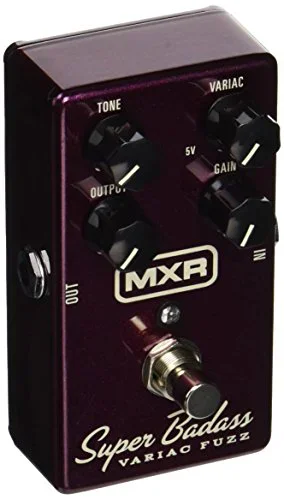
- Fuzz pedal with a rare vintage circuit for unique-sounding distortion effects
- Variac control adjusts from 5 volts to 15 volts to simulate a dying battery
- Powered by a standard 9V AC adapter
- Variac, tone, output, and gain knobs
- True bypass
Exploring New Fuzzy Tastes
The MXR design team dusted off a rare vintage silicon circuit, tuned it up, and added a Variac control so you can set the pedal’s voltage anywhere from 5 to 15V.
That’s how they come up with the Super Badass Variac Fuzz, a fresh (not for the sound, but for the novelty) fuzz pedal that provides snarling, aggressive tones thanks to a hot-rodded vintage circuit.
Coming in a road-ready housing with true bypass switching, it has a simple 4 knob layout to fully customize the effect:
- Tone: high frequencies filter
- Output: overall effect volume
- Gain: amount of fuzz
- Variac: voltage level
What Is That Variac Thing?
As you may have noticed, the Super Badass has one special feature that makes it stand out from other fuzz pedals: the Variac control.
This fourth knob simulates the voltage variations of the battery, which can range between 5 and 15 volts.
Lower the voltage by turning the Variac knob counterclockwise and you will get a dark, compressed fuzz that simulates the fuzz sound you would get from a voltage sag of a dying battery.
Turning it clockwise will open the fuzz for a more transparent and clearer sound.
EarthQuaker Devices Erupter
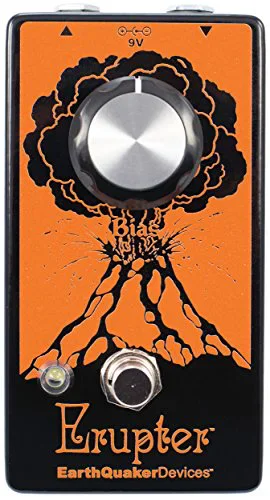
The Erupter was designed as the ultimate classic fuzz, using every last trick in the book to achieve perfection.
- Custom all-analog circuitry, foot-friendly single knob design
- Responds nicely to single-coils and humbuckers alike
- Built in the secret EarthQuaker’s foundry, located under the Mt. AkronVolcano, Ohio (not secret anymore, now they’ll have to send the guys after me)
Seeking Fuzziness Perfection
In case you are wondering what classic pedal is the Erupter trying to emulate or copy… this pedal is actually no clone.
The engineer behind the circuit design spent two years swapping transistors and resistors, adding and removing controls… until the Erupter emerged as the perfect crushing-tone fuzz pedal.
The pedal’s tone is characterized by the following features:
- retains plenty of low-end, smooth top, and just the right amount of gain
- plays nice with wahs
- can be placed at any point in the signal chain
- screams with any guitar and pickup combination
To achieve this, the Erupter has a buffered input section plus a transformer-based pickup simulator to ensure no tone loss across any guitar in your collection, tearing through any impedance mismatches that classic fuzzes are famous for.
At the component level, the Erupter contains a full palette of the highest quality components, including two low-gain specially-matched NOS silicon transistors, new-stock half-watt carbon composition resistors, Sprague and BC capacitors.
Easiest To Use Fuzz Pedal
The Erupter contains only one Bias control, with the fuzz level internally dimed and the Volume pre-set to a universal unity level.
This single knob confines a great power, capable of delivering an incredible range of vintage fuzz tones. Here is how it works:
- When in the center position, the tone will be big and round with a slight volume boost and great sustain.
- As you turn it counterclockwise it becomes more gated with lower output.
- As you turn this clockwise it becomes louder and more refined, adding harmonics onto the signal for a burly, creamy fuzz that tightens up as you increase the knob, all while retaining the optimal volume and fuzz settings.
Wampler Velvet Fuzz V2
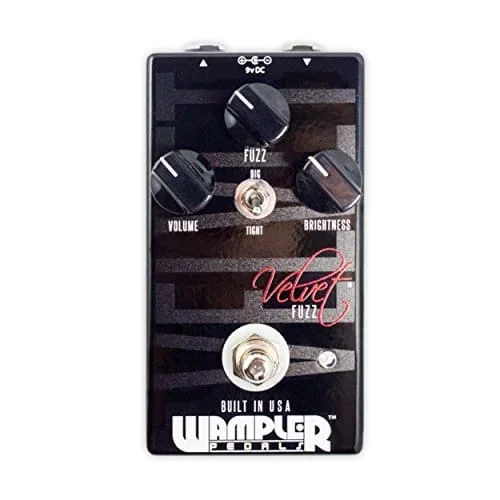
- The quintessential fuzz-into-a-screaming-stack sound
- 2 completely independent clipping circuits: pure fuzz or a fuzz-like distortion
- High-grade film capacitors and resistors for superior sound and response
- Handmade in the USA
- True-bypass circuitry
If you are a fan of the tones of the players like David Gilmour or Eric Johnson, then this could be the pedal you are looking for.
Welcome to a new world of thick as a brick, wall crumbling and window shattering fuzz. Velvet Fuzz.
Overpowered Classic Fuzz
Looking back through the Fuzz tone history, there have been some truly outstanding examples, especially those achieved by running a fuzz into a screaming stack, characterized by their depth, aggression and smoothness.
That’s the idea behind the Velvet Fuzz, a pedal that combines the best of classic fuzz character, power and tone with the sound of an EL34-powered stack.
Best of all is, as you will soon discover, you can switch between the two modes.
Three Knob Layout
The Velvet Fuzz follows the common 3-knobs layout that we can find in any modern fuzz pedal:
- Volume: controls the overall effect output level BUT it has to be compensated depending on where the Fuzz knob is set. When the fuzz is low, the level knob will have to be run a little higher to achieve unity, and the other way around
- Fuzz: controls the amount of distortion and sustain. This knob changes its behavior based on what switch position is selected.
- Brightness: high frequencies filter (Tone knob in other pedals)
Beyond The Knobs: The Voice Switch
With two completely different clipping options (not just the basic silicon or germanium option like most) you can achieve those classic fuzz big tones that compress massively across the bottom or you can tighten them up and have it respond more like a distortion.
You can toggle between the two modes with the Voice switch. Some people say it sounds like a fuzz but feels like a distortion. Get ready to experiment a new kind of fuzz!
- Big mode: deliver a darker and saturated tone, like the classic fuzz tones from the 60s and 70s going into a hot amp. Dropping the volume back cleans it up perfectly so your rhythm can remain clear enough.
- Tight mode: retains a clarity and note definition, even with the fuzz all of the way up. If you love the tone of Fuzz but need a more distortion-ish effect, this is the right setting for you.
ZVEX Fuzz Factory
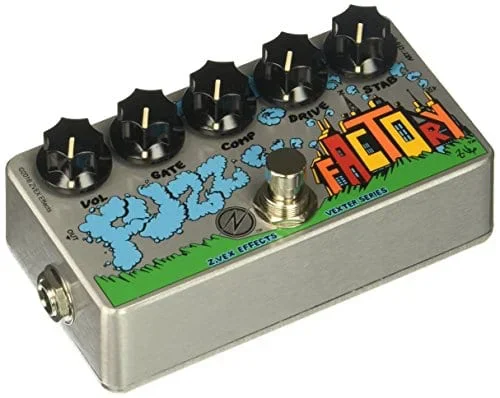
The ZVex Fuzz Factory is one of the earliest pedals invented by Zachary Vex and continues to be his most popular.
It is the heir to the throne of the classic Germanium fuzz boxes of the past, still using New Old Stock Germanium transistors from the sixties.
The controls are highly interactive and encourage hours of sonic exploration. The Z.Vex Vexter Series Fuzz Factory also features a green ON/OFF LED, 9V DC power jack, 2-Year Warranty, and lovely silk screened graphics.
Managing The Factory
From this basic concept Mr. Vex went nuts and added all the knobs he could tocustomize all aspects of the tone:
- Vol: sets the overall effect output volume level.
- Gate: squelches noise after end of sustain. Turn to the right to eliminate squeals, hiss and buzz, stopping just as they disappear, or use to tune in exact feedback pitch, if you’re that kind. Turning to left opens gate.
- Comp: signal compression. Adds attack characteristic when turned to the left, which gets softer to right, and suddenly pinches tone when all the way right. Also tunes in fat, feedbacky fuzz. Lower the Stability and see what happens to this control.
- Drive: increases distortion when used as a “normal” fuzz and adjusts feedback pitch and tonal thickness. This control becomes meaningless when Compress is all the way right.
- Stab: control the fuzz stability (feedback pitch) to produce delicious squeals and oscillations when set to 5 o’clock. Do not adjust this control below 2:00, unless you like your fuzz soft and squishy.
5 Knobs + Low Current Draw = Magics
Like all ZVEX pedals, it’s been designed to run with the lowest current drawpossible. In this case, the Fuzz Factory just needs 27 mW (3 mA @ 9V). It could almost be self-powered from the residual electrical waves from the environment…
About The Multiple Pedal Designs
When I first searched for this pedal on the internet I got a little confused because every pedal image I saw was different from the previous.
So I asked myself: are these different versions? Do they have some different features one from each other? Which one is the latest?
Answer: this pedal is hand painted and they change the design every year or two, but they keep the internals intact.